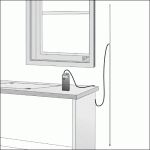I can see the confusion between this and the OCFD, which I have used quite a bit, with some precautions.
If you want to build an OCFD, then YES, a balun is necessary. BUT, what you are really using is the 4:1 transformer part of the balun. The impedance of an OCFD flucuates between about 200 ohms and 500 ohms or so depending on frequency.
The actual antenna is really primarily on 88 mhz, and by using an offset with the transformer, you can get reasonable multi-band use out of it, BUT you can get some funky lobes as you go higher in frequency. This may not matter in a metropolitan situation - BUT another but! This broadband performance may not be desired in a metro area! Talk about catch-22.

88 mhz is the primary frequency this thing is cut for! Typically one uses 1.5 feet of wire/tubing on one side of the 300-ohm terminals, and 4 feet on the other side of the 300 ohm terminal. Put together, this makes for a nice FM broadcast antenna in its own right - something you may not want if you suffer FM broadcast desense.
As for the "balun" part of it, the antenna itself is so electrically unbalanced, that a typical TV-type 4:1 balun is not doing ANY "baluning" at all!

Just the impedance transformation. Some have put snap-on chokes near the feedpoint to play with it.
This means that there is considerable common-mode current along the outer skin-depth of the braid - which actually helps low-band VHF - however that is pretty much a random wire electrically as it snakes around your installation. Officianados of low-band VHF have tried putting snap-on chokes a quarter-wave down the coax from the feedpoint to kind of help low-band vhf even more.
However, they are easy to make with just some wire, a cheap 300:75 ohm transformer, and some clips behind a window curtain for temporary hanging. This makes it easy to do a test-run before building something more substantial.
Another catch is that if you use a long run of coax, and with the 800 mhz SWR not being ideal, you can suffer from the additional SWR loss with lossy coax. That, along with the weird lobes may not make it ideal for 800mhz. You COULD run some really nice low-loss coax to help out, but I've never heard of anyone running good stuff to an OCFD. But yes, overall low-loss coax would be beneficial.


